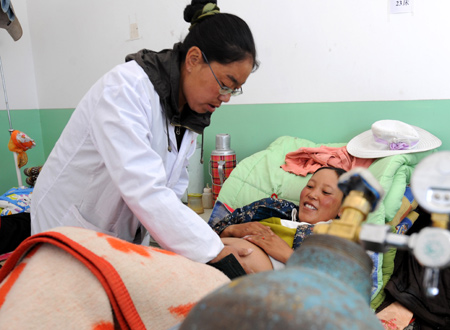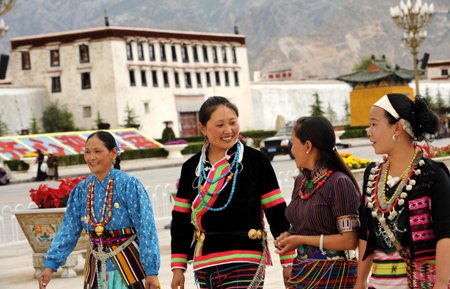The Tibetan women's social status has risen substantially since the democratic reform was launched in Tibet 1959.
More and more Tibetan women are now able to participate in discussing State affairs. They currently enjoy equal rights with men in political, economic, social, cultural and family affairs, and are boosting social progress with their wisdom and talents.
|

|
|
Gesang Zhoigar(C), an offspring of a serf family and a delegate to Tibet Autonomous Region People's Congress (legislature), enters the meeting hall to attend the annual, second session of the Ninth People's Congress of the region in Lhasa, capital of southwest China's Tibet Autonomous Region, Jan. 19, 2009. (Xinhua/Gesang Dawa) |
Deji Droga, in her early 60's, comes from the first group of female doctors engaged in the Tibetan traditional medicine. She was a serf of humble birth previously. Upon the reform in 1959, Droga was given the opportinity to go to Tibetan traditional medical school to study there till 1966.
"The women in old Tibet were underdogs. They weren't allowed to be the Tibetan traditional medical doctors to serve the nobles and senior Lamas. It's really historical progress for women to study this medicine in Tibet, let alone to be doctors," she said.
|

|
|
File photo taken on June 12, 2008 shows a pregnant Tibetan woman receives a medical examination in Dagze County, southwest China's Tibet Autonomous Region. The hospitals in agricultural and pastoral areas of Tibet charge no fee for child delivery. (Xinhua/Chogo) |
Tibetan women hardly had means of production or personal freedom before 1959. However, they have been able to fully enjoy the rights to produce and to be employed since the peaceful liberation in Tibet. Particularly since the policy of reform and opening-up was initiated in 1979, more women have been involved in industrial production. At the end of 2008, Tibet had a workforce of 280,000, 112,000 being females, 40 percent of the total.
In the 1980s, Tibet exercised a compulsory education policy to finance the student's tuition, accommodation and food in all farming and pastoral counties and set up classes for Tibetan students in 16 provinces and cities, offering more chances for Tibetan girls to study.
 |
|
Photo taken on July 10, 2008 shows Tibetan women stroll for shopping in the streets of Lhasa, capital of southwest China's Tibet Autonomous Region. (Xinhua/Chogo) |
Now, the schooling-age girl enrollment rate in Tibet has risen to the regional and national standards, greatly elevating the Tibetan women's educational level.
Moreover, the local maternal mortality rate has fallen sharply as a result of rapid development in medical and health care. Now women are able to enjoy basic medical services, with the minimum standard for free medical care being an annual RMB 140 yuan per person.
Meanwhile, with the extensive spread of the use of computers, mobile phones, radios and television sets in Tibet, modern information technology has made them more accessible to fresh ideas and concepts.
(Xinhua News Agency via Tibet Daily February 18, 2009)